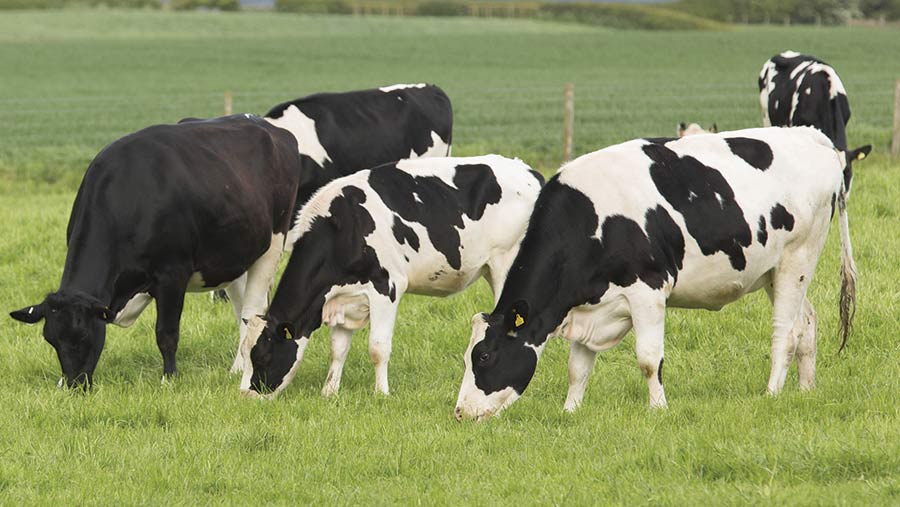How to increase grazed grass without incurring extra costs
 © Tim Scrivener
© Tim Scrivener As we approach turnout and grazing opportunities for more profit, it is essential we all understand why there is so much value and profit in planning and using grazed grass.
News from around the world about the demand for milk products is not good. Milk prices appear to be flatlining, with little likelihood of an increase unless supply falls or demand rises.
Latest EU statistics show some 350,000t of milk product in store, with a need at some time for this to be brought to the market or written off.

Tony Evans is head of business consultancy at the Andersons Centre.
See also: Managing grazed grass
UK milk prices are driven strongly by UK demand and it is only when we go into surplus over our needs that the retailer or milk buyer/food processor can drive the price down again.
My latest worry is that having spoken with various farmers and groups, there are some that want to increase production per cow and cow numbers.
I think the key question is to see if more milk will lower the per-litre cost base (economics of scale) or enable further profitable growth, having already established a low-cost production system.
For those who either graze grass this spring or are thinking of doing so – what happens in the next month or so is essential and can determine the profit made for the next 12 months.
On a rising milk price, as we have seen recently, the challenge for many dairy businesses is how they can maintain or grow the profit on the back of rising inputs costs.
Most notably, we have seen oil price and exchange rates have a massive influence.
Comparison of input costs between February 2016 and February 2017 |
||
|
Feb 2016 |
Feb 2017 |
|
|
Oil/barrel |
US$28.4 |
US$52.5 |
|
Tractor diesel/litre: |
31.7p |
48.4p |
|
Exchange rate |
£1=US$1.43 |
£1=US$1.26 |
|
Fertiliser urea (£/t): |
224 |
290 |
|
Soya (£/t): |
258 |
313 |
|
Wheat (£/t): |
109 |
140 |
|
Source: AHDB Dairy/The Andersons Centre |
||
The potential implication of these price increases is at least 2p/litre. Milk prices in turn have increased by some 6p/litre.
Historically, the cost of producing milk has followed a 4:2:1 ratio of concentrates, grass silage and grazed grass.
So, with input price changes and as milk producers drive for more milk production, have the priorities changed?
Cost comparison of different feed options |
|||
|
Cow cake 16% |
Grass silage |
Grazed grass |
|
|
Rent (£/acre) |
– |
120 |
120 |
|
Reseed (£160/acre) (four years) |
– |
40 |
40 |
|
Fertiliser (£250/t) |
– |
88 |
83 |
|
Machinery costs – Fertilising – Silage-making |
– – |
12 165 |
27 – |
|
Additionals |
– |
15 |
– |
|
Total costs |
230 |
440 |
270 |
|
£/t DM |
270 |
105 |
69 |
|
p/MJ |
2.1 |
0.95 |
0.55 |
|
Cost to produce/litre |
11.3 |
4.0 |
2.9 |
The answer is no, and with sensible total milk production required in the UK, it is a key priority for milk yield to be optimised from grazed grass, silage and cow concentrates – in this order.
Should the price of varying feeds to dairy cows drive your decision on how much to feed?
The answer is yes and no. The key driver for profit is cost of production a litre or a kilogramme of milk solids, depending on the payment system.
However, all dairy farmers, irrespective of their system of milk production, should ask themselves the question: “How can I increase the proportion of grazed grass in my dairy herd’s diet without incurring extra costs in the process?”
Steps milk producers can take to achieve this include:
- Ensuring soil lime status and P and K indexes are optimised and soil condition is conducive to worm activity and deep-rooted grass.
- Walk the farm regularly, measure the amount grown and maintain average covers at 2,200kg DM/ha – this optimises quantity and quality provided.
- Ensure the available milking platform is fully reseeded and accessible by the cows – there is no place for growing forage crops such as maize or wholecrop on the platform at platform stocking rates greater than two cows/ha.
- Intakes of high-quality grass can be as much as 3-4% of a cow’s body weight in dry matter terms, resulting in high milk yield solids and adequate body condition score for good cow fertility.
Beware the legions of people encouraging you to increase milk production as an opportunity to improve your lot.
Before you are tempted by promises of “maximising the cow’s potential”, stop and ask yourself the question – “Who benefits?” Beware not to speed up the next downturn in milk price.
